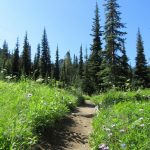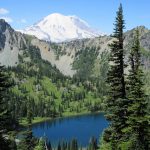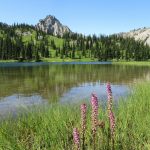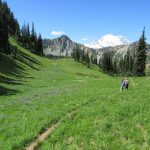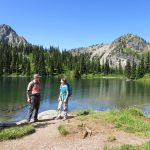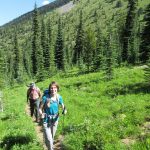| Area: Chinook Pass |
Hike Type: Family-friendly | Pass: No Pass Req |
| Distance: 6.0 mi RT | Duration: 4 hrs | Difficulty Level: Moderate |
| Snow-Free: late-June – Oct | High Point: 5,800 | Elevation Gain: 2,300 |
- IMG 4648
- IMG 4629
- IMG 4607
- IMG 4659
- IMG 4637
- IMG 4652
- IMG 4631
- IMG 4610
Features: exemplary wildflowers, autumn colors, backcountry lakes, backpacking opportunities
Tucked in a cirque high above the Mather Memorial Parkway are a pair of sparkling subalpine lakes beloved by hikers of all ages and abilities. Hike to the Crystal Lakes in early season for a dazzling floral show. Hike to them in autumn for colorful foliage. The lakes make for a fine half day hike or a great place to bed down under the stars. Look for grazing deer, mountain goats and ground squirrels. And push a little farther for jaw-dropping views of Mount Rainier.
Hit the Trail:
Start by crossing the cascading Crystal Creek on a log bridge. Then take a deep breath and get down to business. This trail wastes no time climbing. Wide and well-built, the trail commences in a series of short switchbacks. First, through old-growth, then scrappier younger forest, the trail ascends steep slopes coming down from Crystal Mountain. Crystal Creek crashes below in a tight ravine—mostly out-of-sight, but not out of earshot.
Relentlessly climb—but don’t despair, the grade gets easier the higher up you hike. Notice how dry the forest is here, especially compared to the west side of Mount Rainier. Here the mountain creates a rain shadow. The surrounding forest is fairly young, too. Much of the nearby ridges and basins succumbed to forest fires in the early 20th Century. As you climb higher the forest thins revealing views of surrounding summits and providing excellent wildlife habitat.
Keep heading upward. Pause for a few glimpses of Rainier along the way. At 1.3 miles reach a signed junction. Here the trail to Crystal Peak veers right. You want to continue left, now on a much gentler grade. The forest soon transitions to meadows and clusters of firs. In early summer, an array of wildflower blossoms—lupines, asters, larkspurs, paint brushes and more line the trail and streak the hillsides.
Look north up the open slopes of the multi-summited Crystal Mountain. Pull out your binoculars and look for critters. Deer and mountain goats are commonly sighted. Look south up the craggy pinnacle of Crystal Peak. Look and listen for Clarks nutcrackers. More commonly found on the east side of the Cascade Crest, this large jay-like bird is fond of pine nuts. A scattering of whitebark pines growing in the basin are sufficient to satisfy this bird.
Keep hiking and enter the high basin cradling the lakes. At 2.3 miles reach a junction. The way right leads a short way to the marshy lower lake. It makes for a good destination early in the season, when the upper and higher lake lies buried in snow. There are a couple of forested backcountry campsites here (permit required). Definitely give the lower lake a gander—but it’s the upper lake that makes this hike a beauty—and that’s where you want to hightail it to and spend some time.
Continue hiking a fairly easy .7 mile and reach the upper lake. Situated at 5,800 feet and surrounded by clusters of Christmas tree, flowering meadows, and rocky craggy peaks; it’s a glorious setting. There are backcountry campsites (permit required) near the lake’s outlet. The trail continues along the lake’s north shore passing several inviting spots for snacking, napping, contemplating, and wowing! Pesky gray jays (aka Camp robbers, Canada jays, Whisky jacks) and snooping ground squirrels may invite themselves to your lunch. Resist the urge to feed them, lest they become dependent on human food and end up starving during the winter.
You can lounge on a lakeshore rock for hours, but the surrounding basin calls out to be explored. Follow the trail to the lake’s eastern end where small streams seep into it. In early season, these wet meadows are teeming with orchids. Look for elephant’s head orchids. Take a close look at its flowers and you won’t question why it was given this name. Take care not to walk through this fragile area. Instead, follow the trail leading left and away from the lake. This path heads for a small notch above the basin where it meets up with the Pacific Crest Trail in one mile. Hike it a short distance or all the way to the PCT for some absolutely stunning views of Mount Rainier towering over the upper lake. Eventually, you’ll need to return to the trailhead. And like most Crystal Lakes hikers, eventually, you’ll probably make a return visit here.
Notes: Dogs-prohibited; backcountry camping requires a permit—available at the White River and Longmire Wilderness Information Centers.
Contact: Mount Rainier National Park; https://www.nps.gov/mora/index.htm; (360) 569-2211
Maps: Green Trails Mount Rainier National Park 269S
Trailhead directions: From Enumclaw follow SR 410 for 36.5 miles to trailhead (about 0.5 miles before Sunrise Road turnoff) located on your left. Parking available either side of road—use caution crossing the busy highway.
Trailhead facilities: None; find water and restrooms at nearby Wilderness Information Center on Sunrise Road.
– Craig Romano, is an author of more than a dozen hiking guidebooks including the newly released 100 Classic Hikes Washington (Mountaineers Books) which includes several hikes in and around Mount Rainier National Park.
Waypoints
| Starting Point: N46 55.364 W121 32.022 | |
|
Notable Waypoints: Crystal Peak Trail junction: N46 55.150 W121 31.316 Lower Crystal Lake: N46 54.669 W121 30.828 Upper Crystal Lake: N46 54.346 W121 30.400 |
|
For lodging near this area click here.
Q: Can I camp overnight at Crystal Lakes?
A: Yes, it’ll require a wilderness permit from Mount Rainier National Park. The process of getting a wilderness permit has changed for 2020. Click here for more info.



